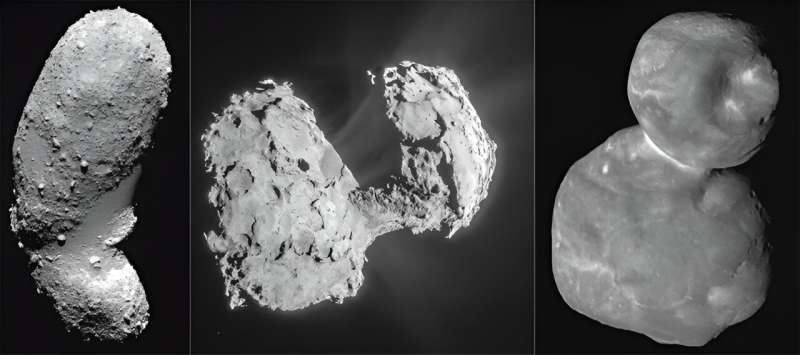Contact binaries are defined as a system when two objects are so close together that their surfaces touch. Typically, astronomers think of the objects as a pair of stars, but asteroids can also form contact binaries.
Recent estimates put the total number of contact binaries as high as 30% of all small solar system bodies, including famous ones like Arrokoth and 67P/Churyumov-Gersasimenko. That means if there are any potentially hazardous asteroids we aren't yet aware of, there's a fair chance it's actually a contact binary.
Such a configuration presents a problem for planetary defense operators. Understanding where to hit a binary to deflect it makes the math much harder. Moreover, we've never seen one of these systems form to understand its underlying mechanisms. The standard model of this process is known as the Binary Yarkovsky-O'Keefe-Radzievskii-Paddack (BYORP) effect, by which the two asteroids, which usually begin in a standard, non-touching binary system, end up having their gravities draw each other together and touch without the catastrophic impact that would be typical of large bodies at higher speeds.
Setting up a contact binary through the BYORP effect would require a separate mission design. According to the paper, a good first effort would be to smack the asteroids into each other using an impactor. There are several advantages to this. A big one is flight heritage—the mission could use a slightly modified version of DART and a coupled observer satellite that could watch the slow-motion impact.
How slow that impact is will have a significant impact on the success of the mission. Hit the billiard ball too hard, and it will smash into its companion and cause a potentially devastating chain reaction. Hit it too softly, and there might not be enough force to push the two objects together. Plenty of math, including simulations of the forces of ejecta fragments, would go into the planning stage of any such mission.
Those simulations require you to know some features of the planned targets, though, and the Cornell researchers have identified one. Known in strikingly formal near-asteroid parlance as (350751) 2002 AW, this system's primary comes in at about 230 m, with a secondary partner measuring about 50 m. One potential advantage of a mission to this system is that the 50 m size of its smaller object is the minimum size limit for possible future planetary defense missions, allowing the mission to emulate a potential real planetary defense scenario.
Plenty of observation will need to take place to effectively plan where best to hit the pair, though, and with how much force to do so. The paper requests plenty of ground-based observational support, including density and orbital measurements. However, it's unclear if there's enough interest in the project yet to warrant diverting those resources to this new effort.
There's also additional work to do, including developing a plan for how the observational satellite could avoid the debris cloud that will form after the impact. Another potential research area is initiating a contact using a gravity tug to force a sped-up BYORP effect.
For now, these ideas remain on the drawing board. But it's nice to see how successful missions like DART can inspire even more ambitious ones in the future. Maybe someday, our skill at cosmic billiards will grow to include an ability to do trick shots, too.
More information: Colby C. Merrill et al, Creating a contact binary via spacecraft impact to near-Earth binary asteroid (350751) 2002 AW, Acta Astronautica (2023). DOI: 10.1016/j.actaastro.2023.11.030
Journal information:Acta Astronautica
Provided by Universe Today



